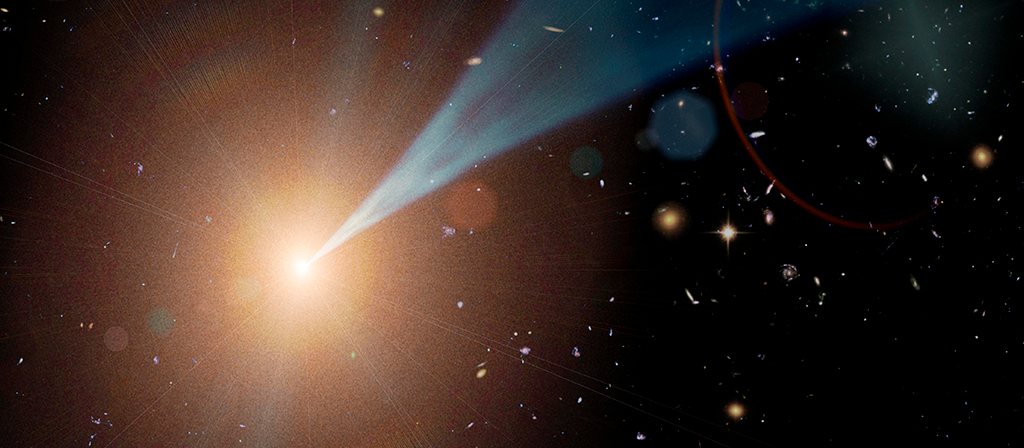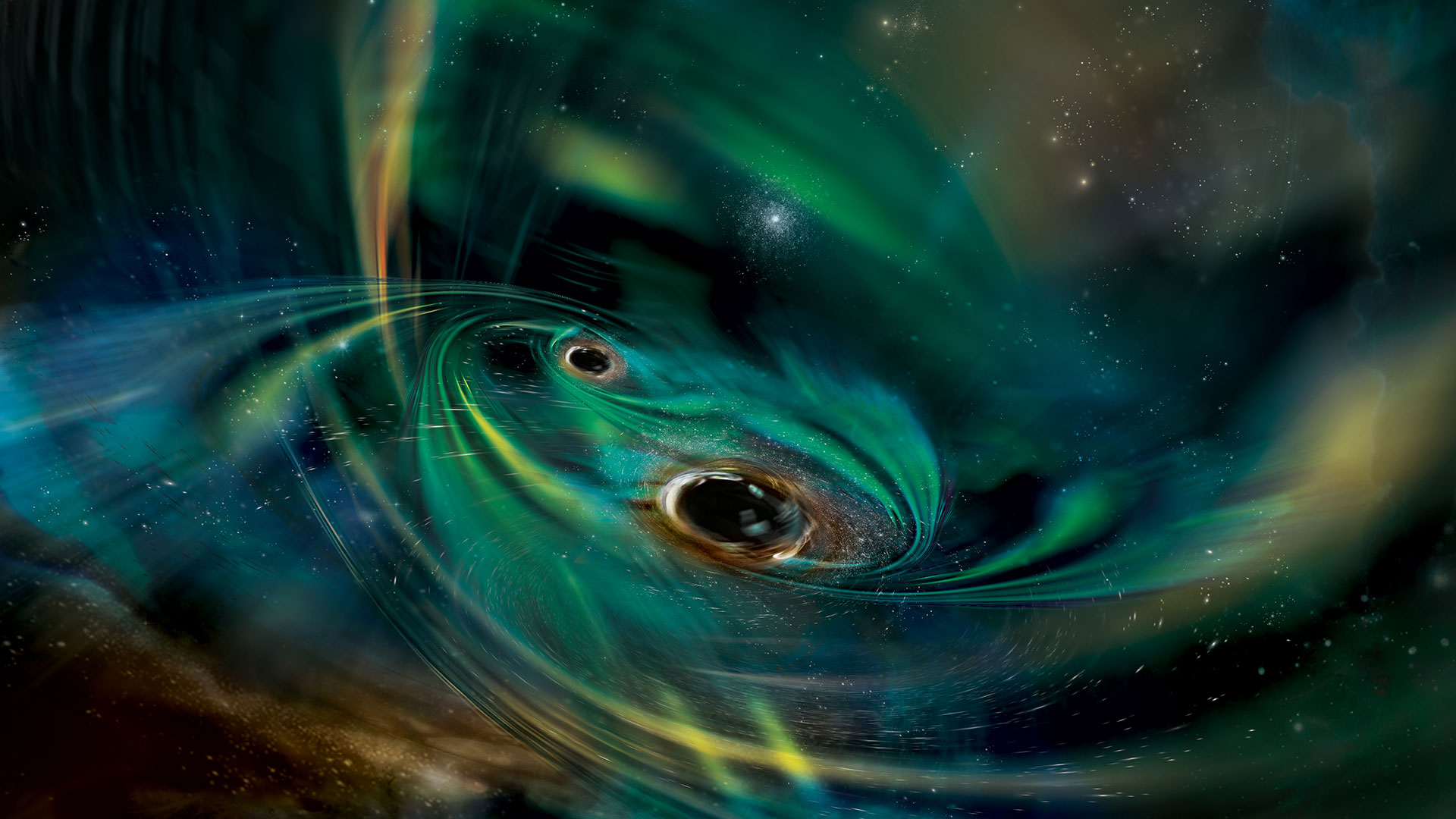
It is PBC J2333.9-2343, a radio galaxy that happened to have a blazar in its core, high-energy objects and one of the most powerful ever studied in the Universe. This research, which participates the Millennium Institute of Astrophysics (MAS) astronomer Lorena Hernández, was highlighted by the Monthly Notices of the Royal Astronomical Society.

Lorena Hernández
No tiene un nombre muy atractivo y para nada especial, pero sin duda la galaxia PBC J2333.9-2343 tiene características especiales que nos permiten entender mejor cómo funcionan las dinámicas dentro de estos importantes objetos estelares. Particularidades que han hecho que sea el objeto de estudio por años de la astrónoma Lorena Hernández, investigadora del Instituto Milenio de Astrofísica MAS en Chile y de su colega Francesca Panessa, del Istituto di Astrofisica e Planetologia Spaziali (IAPS-INAF) de Italia.
“Empezamos a estudiar esta galaxia porque mostraba propiedades peculiares en diferentes frecuencias o energías. Nuestra hipótesis era que el chorro relativista de su agujero negro había cambiado de dirección, pero para corroborar esa idea, debíamos realizar diferentes observaciones. Propusimos un programa de seguimiento en diferentes rangos de energía de esta galaxia, ya que los cambios que podemos observar en ella nos dan información sobre la naturaleza de las regiones que la emiten, y nos permiten entender con mejor detalle los procesos físicos que tienen lugar”, explica Lorena, quien es parte del bróker astronómico ALeRCE (Automatic learning for the rapid classification of event).
This work, published in the renowned Monthly Notices of the Royal Astronomical Society, descubrieron que lo que se produjo en PBC J2333.9-2343 fue que el chorro de partículas originado en las proximidades de su agujero supermasivo, conocido como jet y que se observa como una estructura cónica lanzada a gran distancia por los agujeros negros, al ser acelerado a velocidades relativistas cambió su dirección de forma drástica, pasando de estar en el plano del cielo, a estar alineado a nuestra línea visión, apuntando hacia nosotros, lo que es primera vez que se observa. “Un jet está compuesto por partículas elementales como electrones y protones que se mueven a velocidades cercanas a la de la luz. Estas partículas se mueven de forma circular alrededor de un fuerte campo magnético, provocando la emisión de radiación a través de todo el espectro electromagnético. Cuando apunta en nuestra dirección, la emisión del éste es fuertemente amplificada, pudiendo fácilmente superar la del resto de la galaxia, lo que puede derivar en un comportamiento con “flares” o llamaradas de gran intensidad. Eso cambia la categorización de esa galaxia”, explica.
According to Hernández, when two jets point towards the plane of the sky, it is known as a radio galaxy, whereas one of the jets points towards us, like the PBC J2333.9-2343, the active galactic nucleus of the galaxy is called a blazar. This astronomical phenomenon is one of the strongest, largest energy sources studied in the Universe.
Y aunque cambios en la dirección de los jets, se han descrito anteriormente, como en el caso de las radio galaxias en forma de X, esta es la primera vez que se observa esta morfología, la que no nos da pistas respecto a jets o chorros en diferentes direcciones. “Ello no significa que no existan otros casos, pero son difíciles de identificar. Ahora que conocemos lo que sucedió en PBC J2333.9-2343, es más fácil pensar en formas de buscar otros similares. Lo que podemos decir de este caso particular es que se trata de una galaxia que se sale de la norma de lo que conocemos, ya que su núcleo activo no encaja en los conceptos generales que hemos descubierto. Estudiar este tipo de galaxias que no siguen las reglas comunes nos puede dar mucha información sobre cómo evolucionan, nos puede abrir la mente a nuevos descubrimientos sobre lo que ocurre en lo más profundo de las galaxias”.
Observing at different frequencies
The program that astronomers used in order to get these conclusions were based on data obtained with the German 100m-Radio Telescope Effelsberg at the Max Planck Institute for Radio Astronomy (radio frequency), the Yale University 1,3m-SMARTS instrument (optical and infrared photometry), and data from the Penn State Neil Gehrels Swift Observatory (X-ray and ultraviolet). Complementing the study, the scientists compared variation properties in PBC J2333.9-2343 with large samples of blazars and non-blazars galaxies provided by the ALeRCE project in Chile with data from the Zwicky Transient Facility (ZTF) observations (ZTF) and the Asteroid Terrestrial-impact Last Alert System (ATLAS).“We could study the changes that the galaxy experiences in time with the monitoring data, and we saw the variations in the energies we observed, from the radio frequencies to the gamma rays,” Lorena Hernández states.
In addition to this, public data were included, obtained from other instruments: “Although they are not for variability studies, they are used for other purposes. ”These data are from Fermi Large Area Telescope (gamma rays), the Very Long Baseline Array (radiofrequency at 15 and 24 GHz), Very Large Array Sky Survey (at 3GHz), and the the Very Large Array Sky Survey (0,88 GHz).
With this information, experts concluded that this galaxy has a bright AGN in the centre, with two lobes in the outer areas of the jet. “What is interesting about these galaxies is that the amount of time in which matter could move from the nucleus to the lobes is so long that it could be approximately a hundred million years. During this time, many things may have occurred in the galaxy, like nuclear activity could cease and reactivate after a while or a merging event with another galaxy or any other relatively large object to change the jet direction. We don’t know what happened in this case because it was long ago; however, we can be sure that some powerful event occurred,” says Hernández.
The conclusions drawn from this research include, for example, the observation that the lobes are not being fueled by the core, 'indicating once again that the core is now feeding this blazar.' Additionally, it is noted, 'the fact that we see the emission from the lobes no longer being fed from the core suggests that it is very old emission that has not yet extinguished; in other words, it is the relic of past activity, while structures closer to the core represent younger and more active jets.' "The most challenging aspect of this research was demonstrating that the current jet, appearing as a bright point, is indeed directed straight towards us. This was proven in two ways: by comparing what we know about the brightness variability of jets from other similar galaxies (such as how much they vary on different time scales and the delay between variations in one color of light and another) and by using theoretical models to determine how much light a jet seen under these conditions emits across the entire observable electromagnetic spectrum, from radio waves to gamma rays," states Patricia Arévalo, a researcher at the Institute of Physics and Astronomy at the University of Valparaíso, who was also part of the study.
In this research participated MAS astronomers Francisco Förster, Franz Bauer, Alejandra Muñoz and Paula Sánchez, and a collaboration with researchers from Chile, Italy, Mexico, Switzerland, and Germany.
The MAS astronomers Francisco Förster, Franz Bauer, Alejandra Muñoz, and Paula Sánchez, along with IFA's Lorena Hernandez, Patricia Arévalo, and Rosamaria Carraro, and from the University of Chile, Paulina Lira, all played a crucial role in this research. This collaborative effort also involved researchers from Italy, Mexico, Switzerland, and Germany
Link to Publication
Photo CREDIT: NASA/JPL-Caltech












